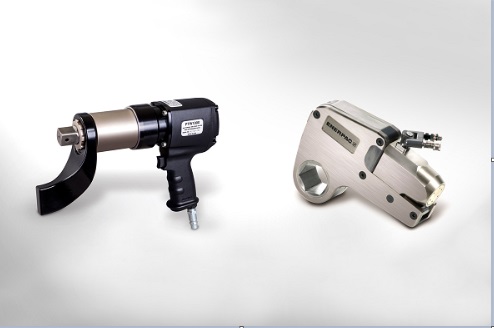Pneumatic vs. Hydraulic Tools
Although these are almost the same in terms of mechanism, the main difference is in their methods of transporting power to the equipment to exert the needed pressure in performing certain tasks. Hydraulics employ fluids, such as oils, while pneumatics utilize compressed gases. Both systems have their own distinct benefits and ideal applications, such as heavy lifting and operating costs.
Pros and Cons
 In terms of sustainability, air-pressure powered tools are typically used when performing maintenance of valves and flanges because the pressure they use is more controllable.
In terms of sustainability, air-pressure powered tools are typically used when performing maintenance of valves and flanges because the pressure they use is more controllable.
Pneumatics display rapid movement of gears and have the advantage of availability in very small sizes. This is mainly due to air compressor flow rates. Air is very agile and can flow through hoses very quickly and easily with little resistance, while hydraulic oil is a viscous substance and requires more energy to move.
Pneumatics offer a very clean system, suitable for food manufacturing and other processes that require no risk of contamination. Due to the risk of hydraulic oil leaks from faulty valves, seals or burst hoses, hydraulics are generally not used in these environments.
Pneumatic tools and valves can dump their compressed air straight to the atmosphere when they need to change direction or alter their state quickly, compared with hydraulic pumps where the oil must be routed back to the reservoir.
However, pneumatics do not have the potential force that hydraulics have to offer. Typical pneumatic systems operate at around 80 to 100 pounds per square inch of pressure, with pressures greater than this restricted by the materials used within the system.
Hydraulic jacks can smoothly lift and move large loads because the hydraulic oil is not compressible. In general, a much larger pneumatic cylinder is needed to obtain the same force that a hydraulic ram can produce.
Safety
In terms of safety, hydraulic equipment trumps pneumatic. Hydraulic fluid is not compressible, so when operating at the same power levels, it is safer and much more controllable than pneumatics.
Due to its stored energy, compressed air is more prone to cause accidents the moment a rapid release of pressured energy due to sudden leaks or rupture in valves. For example, if a 3,000 psi hydraulic tank burst, it would release a small amount of fluid to bring the tank pressure down it 0 psi; whereas breaking the valve off the end of a 3,000 psi pneumatic tank can result in the tank penetrating through cement walls, causing immense damage.
Helpful Tip: If your pneumatic and hydraulic systems are in need of repairs, Aztec Bolting Services provides quality industrial tool repair to minimize downtime.
Cost
When it comes to cost-effectiveness, pneumatic systems are cheaper and easier to maintain than hydraulics. Materials used when manufacturing air-powered tools tend to last longer than that of oil-powered equipment. Looking at operation cost, pneumatic is cheaper as well, and in some cases, even hydraulic power needs the assistance of compressed air to produce the needed power for hydraulic equipment to work.
In conclusion, each system has advantages geared towards specific projects and applications. If you are interested in learning more about pneumatic and hydraulic tools visit Aztec Bolting Services to discover how we can meet your systematic needs.





